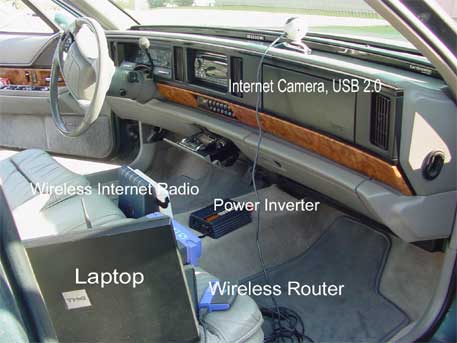June 2006 // Volume 44 // Number 3 // Tools of the Trade // 3TOT1
Mobile Wireless Internet Video: Bringing the Specialist into the Field Remotely
Abstract
The use of mobile Internet video offers an efficient
means for specialist diagnosis of field problems. Costs involved in adoption
of the technology are small. Use of the technology has the potential to reduce
travel expenditures, specialist time required to provide diagnosis, and response
time to clientele.
The Need
Nationwide, Extension has felt the effects of the declining economy. Hiring freezes, reductions in travel, and reduced operational funds are commonplace. While always a priority, the importance of efficiently utilizing operational funds has heightened considerably. The use of technology offers Extension a means to reduce costs and improve outreach efforts. It is a challenge to Extension to integrate both new and existing technology into educational and service programs in order to improve efficiency, reduce costs, and provide clientele with quality advice.
Travel costs comprise a significant portion of operational budgets, and reductions in travel expenditures have lessened the ability of specialists to travel to remote field locations to examine problems in person. Mobile wireless Internet video offers a "low cost" means to bring specialists into the field to assist local agents.
Hardware and Software
The hardware and software described below, with the exception of a few key pieces, are already found in most Extension offices throughout the United States. The widespread use of mobile Internet video and the utility of this technology is dependant only upon the ability of Extension personnel to assimilate and adopt the technology. The costs are very low, and in many cases all of the components are already in place and only require configuration and use (Figure 1).
Figure 1.
Components Needed by an Agent "in the Field" for Wireless Internet
Video

For the specialist in a stationary location components needed include:
-
A relatively fast desktop computer to reside in proximity of the specialist
-
A "high-speed" Internet connection
-
"Yahoo Messenger" or "MSN Messenger" software application
For the Agent "in the field" components needed include:
-
Relatively fast battery powered laptop computer (or Tablet PC)
-
USB Wireless Internet adaptor
-
USB Internet video camera
-
300 W DC to AC power inverter
-
Wireless router / access point
-
15 db "Hi-Gain" antennae
-
Wireless "high-speed" Internet connection (equipment is usually provided with the service and consists of a radio type receiver)
- "Yahoo Messenger" or "MSN Messenger" software application
(free)
- Computer hardware quality changes very rapidly. It is recommended that a computer used for video transmission be less than 2 years old. An ideal configuration would be a 2.4 ghz (or faster) clock speed Pentium IV processor, 400-800 mhz front side bus, 512 MB internal memory, hyperthreading capable and turned on, a minimum 128 MB graphics card, and USB 2.0 ports.
-
For the best results, it is recommended that the video camera be as portable as possible and USB 2.0 capable.
-
A 150W power inverter works to power the router and wireless radio; a 300W inverter is needed to also charge the laptop.
-
A wireless "G" protocol router would provide better quality (i.e., faster transmission) if the laptop was equipped with a wireless "G" adaptor.
-
The "Hi-Gain" antennae increases the distance and quality of video transmission, but may not be required depending upon the Internet provider service quality.
It is likely most of the equipment listed above already exists in Extension offices and is capable of being used to transmit mobile video. A general cost breakdown for all of the equipment listed above is provided (Table 1).
|
Desktop Computer |
$1000-1500 |
|
Laptop Computer |
$800-1200 |
|
Video Camera USB 2.0 |
$80 |
|
Power Inverter 300W |
$50 |
|
15 db "Hi-Gain" antennae |
$100 |
|
Wireless router |
$80 |
|
Wireless Internet service |
$90 / month (T-1 speed) |
|
Messenger software |
"free" |
Note that the two largest costs listed above are the computers. Most offices already have computer equipment capable of handling video transmission. If computer costs are not factored into the expense, mobile video can be realized for less than a $300-400 one-time expense and a recurring cost of $90 per month for wireless T-1 speed service.
Performance
The video quality of this type of connection is stunning. The speed of the wireless connection typically averaged 1200-1400K, and video frame rate was consistently 26-30 frames per second, with little to no distortion or break up. Voice carried over the same signal was clear. As the wireless router was transmitting through outdoor conditions, the laptop was able to maintain a high-speed connection within 300 feet of the vehicle. The vehicle housing the wireless receiver and router was located 15 miles from the main Internet transmission tower; however, adequate signal was received up to 25 miles away. A digital camera in macro mode was used to take "in-the-field" high-quality 4 megapixil close-up photos of disease spots on a leaf. Transfer of each one-megabyte photo took less than 10 seconds.
Recommendation
Wireless Internet video is available in many communities across the nation. While this service is intended for fixed and not mobile applications, use in a mobile environment is cost efficient and readily attainable. Given the low cost of initial setup, current cost of fuel for travel, and interest in time efficiency, mobile video is a viable option for increasing "on-the-spot" specialist input into field diagnostics.
